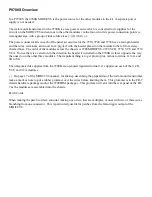
Appendix
43
Operating Instructions - Dedy Chocolate Enrobing Machine 220 mm and 320 mm
11.2. Information on the processing of chocolate
What is tempering?
“Tempering” chocolate means preparing the chocolate in such a way that it
takes on the right crystalline form after it has been processed, i.e. while it is
setting.
Only correctly tempered chocolate will have a consistently perfect texture,
re
fl
ected by its beautifully shiny surface and its smooth and creamy melt-in-
the-mouth quality as well as by the way that it snaps easily and by the fact that
it keeps well. The word “temper” is usually used synonymously with the word
“pre-crystallisation” although the latter is more descriptive of the
preparatory process because the temperature is not the only critical factor here
but also the right crystalline form of the chocolate. There is a tendency during
the cooling process for unwanted crystals to form, frequently resulting in grey
and white speckles or a dull surface on the chocolate which has also lost its
ability to contract, becomes grainy and melts quickly when stirred. The fat
content in the chocolate consists of several structures with different melting
points. Therefore the chocolate needs to be melted
fi
rst at a temperature of
approx. 45 °C, guaranteeing that all the fat structures are lique
fi
ed and that
there are no more crystals.
The following temperatures are a guide when melting the chocolate in this
fi
rst
instance:
•
Dark chocolate: approx. 45 to max. 50 °C
•
Milk chocolate: approx. 42 to max. 45 °C
•
White chocolate: 40 °C
These temperatures need not be adhered to as precisely as the temperatures
later on in the process when cooling. As a general rule, the higher the cocoa
content, i.e. the darker the chocolate, the higher the heating-up temperatures
can be. White chocolate is the most sensitive and should not be heated much
above 40 °C.
Please also refer to the instructions of the chocolate manufacturer.
During the subsequent cooling process, tempered chocolate or small pieces of
chocolate are added to the chocolate so that the liquid chocolate is “seeded”
with the right crystals and cools down, thereby enabling the crystals to multiply.
The three factors which play a part in the tempering process are time,
temperature and movement.
Every type of chocolate must be tempered before it can be used in shapes and
moulds, to make hollow
fi
gures and to coat cakes or praline
fi
llings. This is how
it gets a perfect shine and the right “bite”.






































